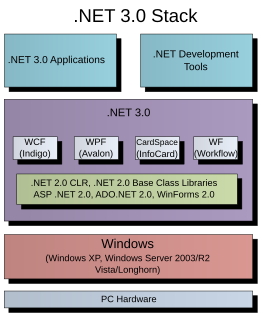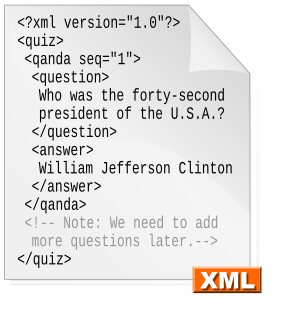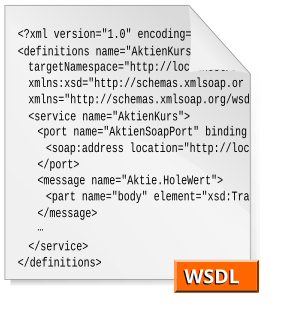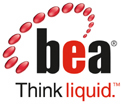The Session Initiation Protocol (SIP) is a signaling protocol used for initiating, maintaining, and terminating real-time sessions that include voice, video and messaging applications. SIP is used for signaling and controlling multimedia communication sessions in applications of Internet telephony for voice and video calls, in private IP telephone systems, in instant messaging over Internet Protocol (IP) networks as well as mobile phone calling over LTE (VoLTE).
Web Services Security is an extension to SOAP to apply security to Web services. It is a member of the Web service specifications and was published by OASIS.
The WS-I Basic Profile, a specification from the Web Services Interoperability industry consortium (WS-I), provides interoperability guidance for core Web Services specifications such as SOAP, WSDL, and UDDI. The profile uses Web Services Description Language (WSDL) to enable the description of services as sets of endpoints operating on messages.
Web Services Discovery provides access to software systems over the Internet using standard protocols. In the most basic scenario there is a Web Service Provider that publishes a service and a Web Service Consumer that uses this service. Web Service Discovery is the process of finding suitable web services for a given task.
Web Services Resource Framework (WSRF) is a family of OASIS-published specifications for web services. Major contributors include the Globus Alliance and IBM.
The Media Dispatch Protocol (MDP) was developed by the Pro-MPEG Media Dispatch Group to provide an open standard for secure, automated, and tapeless delivery of audio, video and associated data files. Such files typically range from low resolution content for the web to HDTV and high-resolution digital intermediate files for cinema production.
In computing, the same-origin policy is an important concept in the web application security model. Under the policy, a web browser permits scripts contained in a first web page to access data in a second web page, but only if both web pages have the same origin. An origin is defined as a combination of URI scheme, host name, and port number. This policy prevents a malicious script on one page from obtaining access to sensitive data on another web page through that page's Document Object Model.

The Windows Communication Foundation (WCF), previously known as Indigo, is a runtime and a set of APIs in the .NET Framework for building connected, service-oriented applications.
A Web API is an application programming interface for either a web server or a web browser. It is a web development concept, usually limited to a web application's client-side, and thus usually does not include web server or browser implementation details such as SAPIs or APIs unless publicly accessible by a remote web application.
WS-MetaDataExchange is a web services protocol specification, published by BEA Systems, IBM, Microsoft, and SAP. WS-MetaDataExchange is part of the WS-Federation roadmap; and is designed to work in conjunction with WS-Addressing, WSDL and WS-Policy to allow retrieval of metadata about a Web Services endpoint.
The Java API for XML Web Services (JAX-WS) is a Java programming language API for creating web services, particularly SOAP services. JAX-WS is one of the Java XML programming APIs. It is part of the Java EE platform.
The Devices Profile for Web Services (DPWS) defines a minimal set of implementation constraints to enable secure web service messaging, discovery, description, and eventing on resource-constrained devices.
Web Services Enhancements (WSE) is an obsolete add-on to the Microsoft .NET Framework, which includes a set of classes that implement additional WS-* web service specifications chiefly in areas such as security, reliable messaging, and sending attachments. Web services are business logic components which provide functionality via the Internet using standard protocols such as HTTP. Web services communicate via either SOAP or REST messages. WSE provides extensions to the SOAP protocol and allows the definition of custom security, reliable messaging, policy, etc. Developers can add these capabilities at design time using code or at deployment time through the use of a policy file.
Apache CXF is an open-source, fully featured Web services framework. It originated as the combination of two open-source projects: Celtix developed by IONA Technologies and XFire developed by a team hosted at Codehaus. These two projects were combined by people working together at the Apache Software Foundation and the new name CXF was derived by combining "Celtix" and "XFire".
WS-SecurityPolicy is a web services specification, created by IBM and 12 co-authors, that has become an OASIS standard as of version 1.2. It extends the fundamental security protocols specified by the WS-Security, WS-Trust and WS-SecureConversation by offering mechanisms to represent the capabilities and requirements of web services as policies. Security policy assertions are based on the WS-Policy framework.
gSOAP is a C and C++ software development toolkit for SOAP/XML web services and generic XML data bindings. The gSOAP tools generate efficient source code for XML serialization of any type of C/C++ data with zero-copy overhead.





